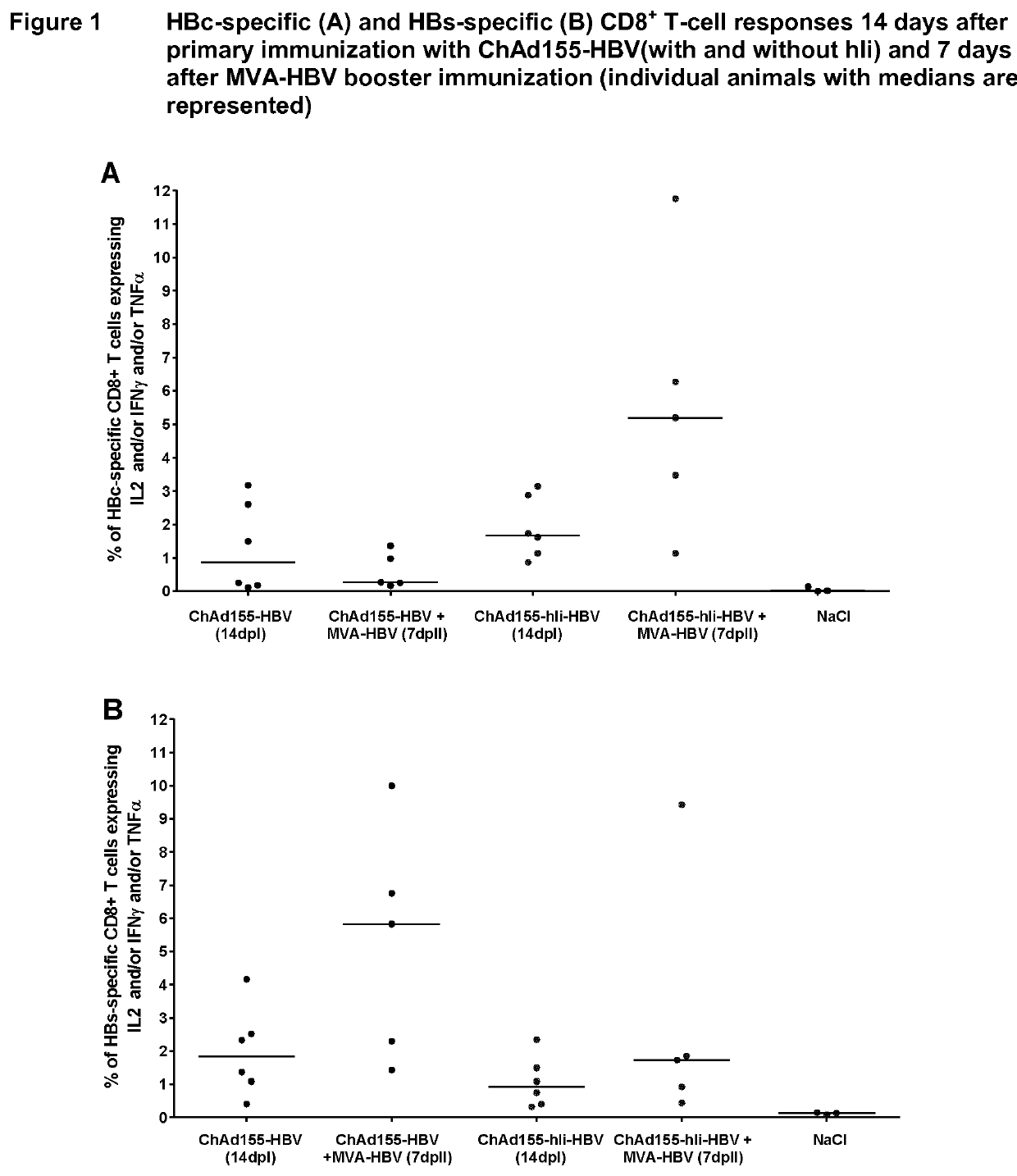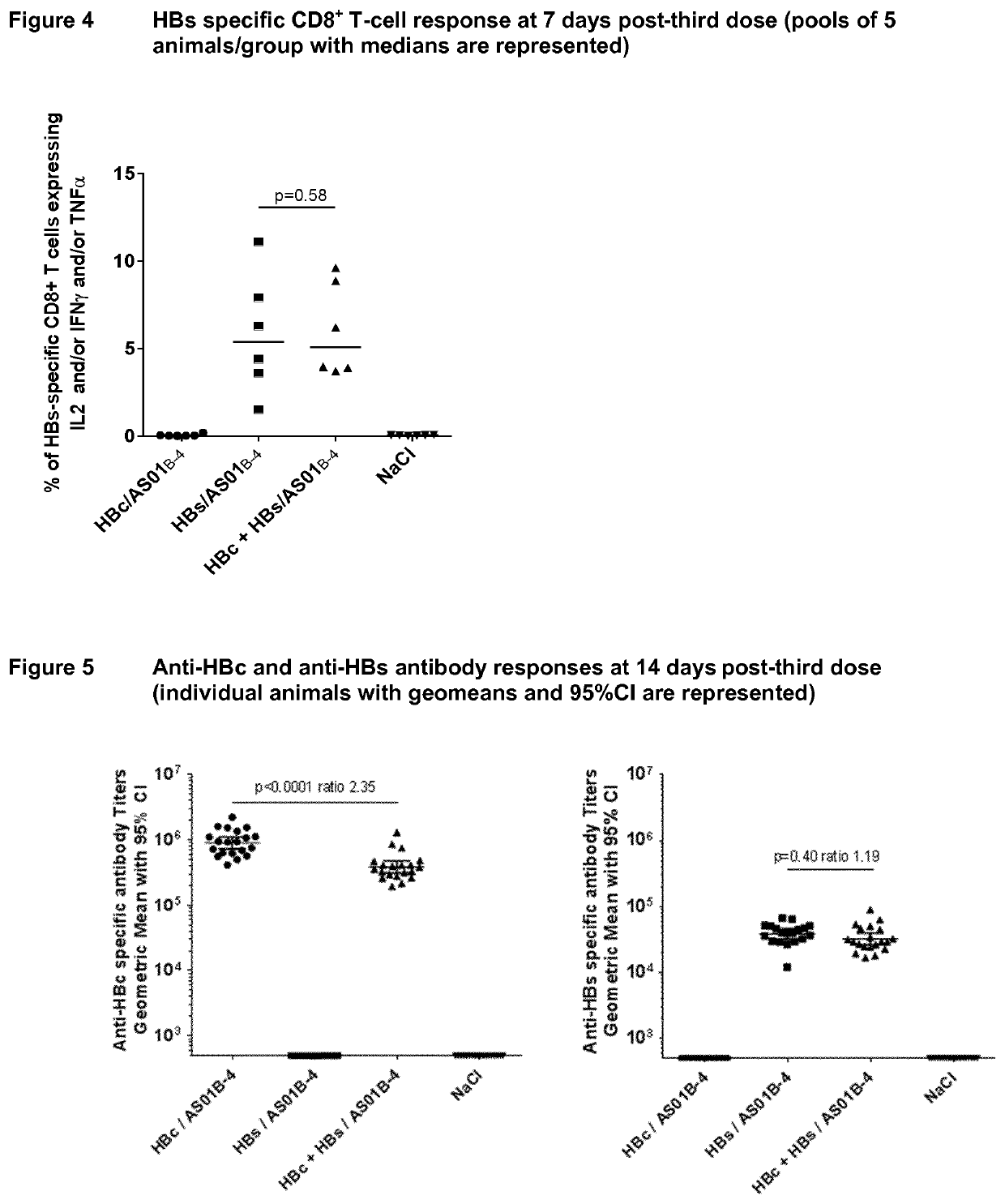Hepatitis b immunisation regimen and compositions
a technology of hepatitis b and composition, applied in the field of hepatitis b immunisation regimen, can solve the problems of affecting the incidence of hbv-related deaths, the prevalence of chronic hepatitis b infection (chb) in adolescents and adults, and the hbv infection is a major public health problem
- Summary
- Abstract
- Description
- Claims
- Application Information
AI Technical Summary
Benefits of technology
Problems solved by technology
Method used
Image
Examples
example 1
n of ChAd155-HBV (with and without hIi) Prime and MVA-HBV Boost in HLA.A2 / DR1 Transgenic Mouse Model
Objectives
[0232]The main objective of this experiment was to determine whether priming with one dose of ChAd155-HBV (with or without hIi) followed by a booster dose of MVA-HBV, was able to induce a strong CD8+ T cell response against HBc in HLA.A2 / DR1 mice which are transgenic for human MHC-I / II molecules. In addition, a head-to-head comparison between ChAd155-HBV with and without hIi was performed to investigate the potential of the hIi sequence to further increase HBc-specific CD8+ T-cell responses, as previously reported for other antigens [Spencer, 2014; Capone, 2014]. HBs-specific CD8+ T-cell responses as well as HBc- and HBs-specific CD4+ T-cell and antibody responses were also evaluated.
Study Design
[0233]HLA.A2 / DR1 mice (11 mice per group) were immunized with 108 vp of ChAd155-HBV (with and without hIi) through intramuscular route at Day 0 and boosted with 107 pfu of MVA-HBV (w...
example 3
Comparison Experiment in Inbred Mice (CB6F1)
Objectives
[0251]The main purpose of this experiment was to compare the ability of HBc and HBs antigens, at a ratio of 4 to 1 formulated with different adjuvants (Alum, AS01B-4 or AS01E-4) or without adjuvant, to induce a strong CD4+ T-cell and humoral response against both antigens.
Study Design
[0252]CB6F1 mice (35 mice for Groups 1-4 and 25 mice for Group 5), 6 to 8 weeks old, were immunized three times intra-muscularly at Days 0, 14 and 28 with HBc-HBs antigens (4 μg-1 μg) formulated with alum, AS01B-4 or AS01E-4 (listed in Table 3 below). The AS01E-4 Adjuvant System contains half of the quantities of the immuno-enhancers QS-21 and MPL compared to AS01B-4. The HBc- and HBs-specific T cell responses were measured on fresh PBLs 7 days post-second and third dose, after ex vivo 6-hour re-stimulation with pools of peptides and the anti-HBs and anti-HBc antibody responses were measured by ELISA at 14 days post second and third dose.
TABLE 3Treat...
example 5
n of T and B-Cell Tolerance to the “Invariant Chain” Sequence Ii Encoded by the ChAd155 Vector: Use of a ChAd155 Construct Coding for the Mouse Ii Sequence (mIi) in CB6F1 Mice
Objectives
[0271]An immunogenicity study was conducted in CB6F1 mice to investigate T- and B-cell tolerance to the “invariant chain” sequence Ii in a homologous model using a ChAd155 construct coding for the mouse Ii sequence (mIi): ChAd155-mIi-HBV.
Study Design
[0272]Induction of autologous mIi-specific immune responses was evaluated by IFN-γ ELISpot (in splenocytes) and by ELISA (in blood serum) after 2 intramuscular immunizations (Day 0 and 14) with a high dose (109 vp) of the ChAd155-mIi-HBV vector (Table 5).
TABLE 5Treatment groupsGroupsFormulations1ChAd155-mIi-HBV (109 vp) at Days 0 and 142PBS at Days 0 and 14
Methods
[0273]For T-cell responses, 15mer peptides overlapping by 11 amino acids encompassing the murine Ii sequence and arranged into a pool were used as antigen in the IFN-γ-ELISpot assay. For antibody ...
PUM
| Property | Measurement | Unit |
|---|---|---|
| time | aaaaa | aaaaa |
| time | aaaaa | aaaaa |
| time | aaaaa | aaaaa |
Abstract
Description
Claims
Application Information
 Login to View More
Login to View More - R&D
- Intellectual Property
- Life Sciences
- Materials
- Tech Scout
- Unparalleled Data Quality
- Higher Quality Content
- 60% Fewer Hallucinations
Browse by: Latest US Patents, China's latest patents, Technical Efficacy Thesaurus, Application Domain, Technology Topic, Popular Technical Reports.
© 2025 PatSnap. All rights reserved.Legal|Privacy policy|Modern Slavery Act Transparency Statement|Sitemap|About US| Contact US: help@patsnap.com



